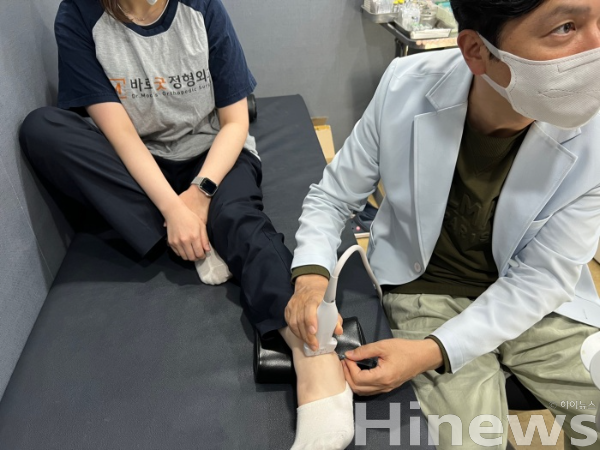Winter’s First Snow in Gangwon Province Signals Caution for Ankle Sprains on Icy Paths
[Physician's Column] By Dr. Ji-ho Moon, Barogood Orthopedic Clinic
Ignoring a sprain—slapping on a patch or self-medicating—risks chronic pain or joint instability. Immediate diagnosis and stage-specific care are non-negotiable.
Cold stiffens muscles and ligaments; bulky winter clothing dulls balance. Lateral ligament damage predominates. Once torn, incomplete healing invites repeat injury. Never assume “just a tweak.” X-rays or ultrasound pinpoint severity.
Sprains fall into three grades:
- Grade 1: Ligaments stretch; pain is mild, daily function intact.
- Grade 2: Partial tear; swelling, sharp pain, and limping ensue.
- Grade 3: Complete rupture; weight-bearing is impossible; surgery is often required.
Higher grades lengthen recovery; early precision diagnosis is critical.

Grade 1 responds to the PRICE protocol: 'P'rotection, 'R'est, 'I'ce, 'C'ompression, 'E'levation.
If pain or swelling persists beyond 2–3 days, seek orthopedic evaluation—simple sprains can mask fractures.
Grade 2 and above benefit from prolotherapy: high-concentration injectables trigger tissue regeneration and ligament strengthening. Unlike steroid shots that merely mask pain, prolotherapy targets root repair. Operator expertise in ankle anatomy is paramount.
To ease injection anxiety, clinicians now pair prolotherapy with cryo-analgesia—pre-injection coolant gas numbs skin instantly. The technique is safe even on sensitive zones.
Grade 3 tears usually require surgical reconstruction. Ankle sprains may spare bone yet destabilize the joint. Taping, hot packs, or over-the-counter patches fall short; systematic diagnosis and phased therapy prevent sequelae.
Undiagnosed or undertreated sprains breed chronic instability. With accurate grading and tailored intervention, most patients avoid the operating room. In winter, one slip warrants prompt medical review.
Lim Hye Jung / press@themedik.kr
Headlines
-
 Healthcare
Healthcare
Finding a Lump in Your Breast: Why It’s Not Always Cancer and What to Do Next
-
 Healthcare
Healthcare
As Winter Bites, Pet Kneecaps Slip: The Hidden Threat of Patellar Luxation in Dogs and Cats
-
 Wellness
Wellness
Korean Herbal Tea Culture: A Wellness Tradition for Body and Mind
-
 Healthcare
Healthcare
How to Counteract Caffeine’s Effects for Better Sleep
-
 News
News
Celltrion Launches Aptozma Biosimilar in U.S. Market: 35% Price Reduction and Blue Cross Coverage for Autoimmune Treatment
-
 Healthcare
Healthcare
Blue Light: Is It Really a Threat to Your Eyes and Health?
-
 Healthcare
Healthcare
The Hidden Health Risks of Your Showerhead: Why Regular Cleaning Matters
Doctors & Hospitals
-
 Healthcare
Healthcare
Eczema: Blending Conventional Relief With Korean Herbal Medicine for Lasting Skin Health
-
 Healthcare
Healthcare
Warts: Beyond Simple Removal—Focus on Immunity for Lasting Relief
-
 Healthcare
Healthcare
AI-Powered Smartphone Tool Opens New Path for Early Autism Screening in South Korea
-
 News
News
Korean Surgeon Pioneers Remote Bladder Cancer Surgery Training Using Da Vinci 5 Platform
-
 Healthcare
Healthcare
Myocardial Infarction Risks Surge in Fall: How to Protect Your Heart
-
 Healthcare
Healthcare
Innovative Korean Acupuncture Therapy Offers Hope for Acne Scar Treatment
-
 Healthcare
Healthcare
Thyroid Surgery and Recovery: Essential Post-Operative Care Guide






